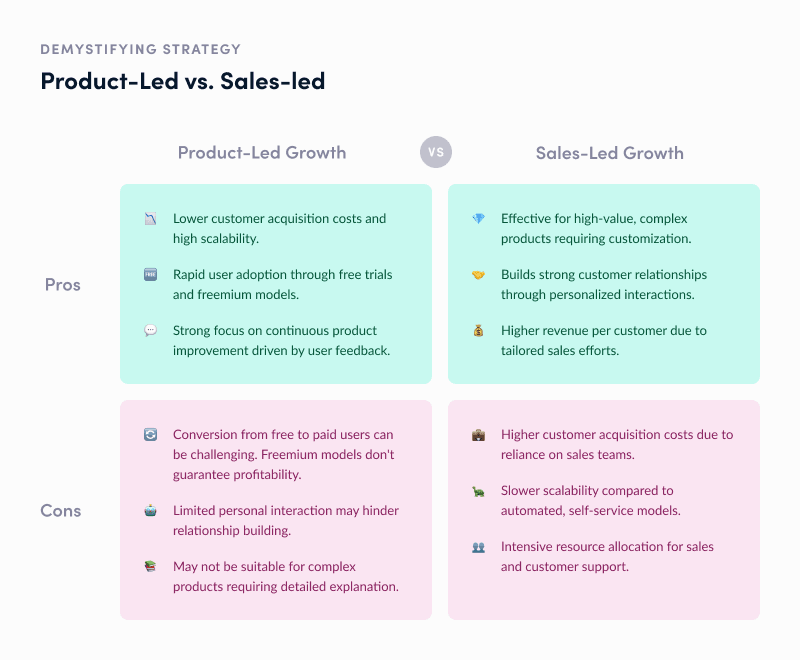Updated: October 9, 2025- 16 min read
Product-led growth (PLG) strategies leverage the product itself as the primary driver of growth for a company, deprioritizing the role of sales and marketing campaigns and instead opting for a product-down approach. PLG caters to new and existing users through the product itself using strategies like freemium subscriptions, free trials, viral growth loops, and referral programs.
In this article, we’ll cover the product-led growth frameworks that make it possible to approach it in a holistic and sustainable way, along with specific strategies for all segments of the PLG flywheel, including how to choose between offering free trials or freemium plan.
We’ll also cover the most important product-led growth metrics you need to track to measure your strategy’s success and examples of real PLG companies that have inspired an entire generation of Product Managers to let the product lead the way.
Growth Metrics Cheat Sheet
Master the metrics you need to keep things moving 'up and to the right'! Our Growth Metrics Cheat Sheet covers 45 metrics to measure success at every stage—from acquisition to revenue and referral.
Get the Cheat Sheet
What Is Product-led Growth?
Before we get ahead of ourselves, let’s define PLG. The basic idea of product-led growth is show, don’t tell. Instead of a massive billboard with a tantalizing photo of fried chicken, let customers try a crispy sample. If they like one, chances are they’ll order a 10-piece box. While the free sample approach works to a certain extent in brick-and-mortar stores (Costco, anyone?), digital products are where PLG can operate at scale and maximize benefits, as we’ll discuss in this article.
Compared to the sales-led model, product-led growth is interesting because it's incredibly scalable.
— Rachel Obstler, Heap EVP of Product
Characteristics of Product-led Growth Strategies
No PLG strategy is exactly the same, but most share several key characteristics:
Build habit-forming products that people love using
Encourage collaboration: Make the experience even better if friends/colleagues use the product
Seamless sign-up and onboarding processes
Product features promote virality with built-in growth loops
Minimize TTV (Time to Value)
Freemium or free trial model to deliver immediate value
Prioritize end-user experience
Iterate based on user feedback to increase satisfaction and drive organic growth
Personalized experience to encourage customer loyalty and retention
Marketing vs. Sales vs. Customer vs. Product-Led Growth
Before product-led, there was sales-led and marketing-led growth. And let's not forget about customer-led! So what’s the difference between these approaches?
Marketing-led growth
Marketing-led growth relies on a company’s marketing efforts to drive revenue. This is often done through content marketing, with a company creating a learning hub for its users consisting of eBooks, white papers, and webinars. This content creates a growth loop that leverages social media to turn its audience into a loyal community, which elevates the brand, and generates interest in the product.
As with the sales function, there’s also a hybrid approach: product-led marketing. This is the approach of bringing a product to market, promoting it, and driving its adoption among target users that focuses on the product’s unique value and solving user problems.
Sales-led growth

Sales-led growth puts your sales team at the forefront of your revenue-driving efforts. With this mindset, all of the leads gained across a company’s efforts are funneled into the sales team, who are relied upon to close the deals and make the final sales. Sales-led has driven incredible growth in the early stages of some of the world’s biggest companies, such as Salesforce and Oracle.
The fundamental difference between sales-led and product-led growth is how a potential customer becomes familiar with and convinced to buy the product. If this is through a free trial, then we’re talking product-led. If, on the other hand, it’s through a series of demos, dinners, and discussions with a sales rep, then that’s sales-led.
There's also a hybrid approach, product-led sales. Product-led sales starts with the product at the forefront, enabling users to experience its value firsthand through free trials, freemium models, or other self-service options. Once users are actively engaged and see the product’s benefits, a dedicated sales team steps in to further nurture these leads and guide them through the purchasing process.
Customer-led growth
Customer-led growth starts not with your funnel, but with your user. This approach is centered around real customer needs. Growth happens when teams build feedback loops—through interviews, in-product feedback, user behavior insights, and community engagement—and translate those insights into action.
Unlike marketing-led growth, which broadcasts a message, or sales-led growth, which drives relationships through a team, customer-led growth is about co-creating value with your audience. It thrives on empathy, continuous improvement, and measuring success based on long-term customer outcomes. While this approach can drive strong retention and organic advocacy, it also risks being reactive or slow to scale if teams over-index on individual requests. And unlike product-led growth—which drives adoption through hands-on product experience—customer-led growth relies more on direct feedback and human connection to shape the overall growth strategy.

Product-led Growth Frameworks
To implement a successful product-led growth strategy, there are several well-known frameworks that can guide your approach:
1. AAARRR Framework (Pirate Metrics)
Best for: Products that have a clear user journey, especially SaaS products and consumer applications where tracking user behavior through distinct stages is crucial.
The AAARRR framework, coined by Dave McClure, stands for Awareness, Acquisition, Activation, Retention, Revenue, and Referral. These metrics help guide the journey from initial awareness to becoming a loyal customer.
A | Awareness ●●●●●●●●●●
A | Acquisition ●●●●●●●●
A | Activation ●●●●●●
R | Retention ●●●●
R | Revenue ●●●
R | Referral ●●
The AAARRR framework helps you focus on optimizing each stage of the user journey to ensure sustained growth. It provides a clear roadmap to understanding how your product is performing and where the gaps might be.
Pros:
Provides a clear structure for tracking user behavior through the entire funnel.
Helps identify specific areas to improve for better growth.
Cons:
Can be too linear for products that have complex, non-sequential user journeys.
May not fully capture network effects or user-to-user interactions.
2. Bowtie Framework
Best for: Subscription-based products and those that require a strong focus on customer retention and expansion, such as B2B SaaS platforms.

The Bowtie Framework is a visual representation of both pre-and post-purchase user journeys. It emphasizes not only the initial conversion but also the ongoing value delivery and retention.
On one side of the bowtie, you have acquisition and activation stages leading up to the point of conversion.
The knot represents the moment of conversion when a user decides to buy or commit to your product.
On the other side, the focus shifts to retention, expansion, and advocacy, ensuring that users continue to derive value and, ideally, upgrade or promote the product to others.
This framework is particularly effective in ensuring a holistic view of the customer journey, taking into account both how users come to the product and how they continue to engage with it after purchase.
Pros:
Provides a comprehensive view of the entire customer journey, both pre-and post-purchase.
Focuses on delivering continuous value to users, which is crucial for retention.
Cons:
Can be challenging to implement for products without a clear retention or expansion strategy.
Requires significant resources to track and optimize both sides of the bowtie effectively.
3. Growth Loops
Best for: Products with built-in network effects or those that thrive on user-to-user engagement, such as social media platforms, marketplaces, or collaborative tools.
Unlike traditional funnels, which are linear, growth loops are continuous cycles where each completed loop drives more users into the next cycle. Growth loops are highly scalable because each input creates a bigger output, leading to compounding growth.

For example, consider a user who signs up for a product, enjoys the experience, and then invites their colleagues to join as well. This input leads to multiple outputs (more sign-ups), which then repeat the cycle. Growth loops can be powered by viral features, content sharing, network effects, or incentives that encourage user-to-user engagement.
By focusing on growth loops, companies can create self-sustaining growth mechanisms where each action by a user leads to more value and more users over time.
Pros:
Encourages compounding growth, making it highly scalable.
Focuses on creating sustainable growth through user actions.
Cons:
Difficult to implement if the product lacks natural virality or network effects.
Requires careful monitoring to ensure the loop remains effective and doesn’t stagnate.
4. Hooked Model
Best for: Consumer products and apps where building user habits is key to long-term engagement, such as fitness apps, social media platforms, and productivity tools.
The Hooked Model, developed by Nir Eyal, explains how to create habit-forming products that keep users coming back. It’s made up of four key phases: Trigger, Action, Variable Reward, and Investment.
Trigger: What prompts the user to take action? Triggers can be external (like a notification) or internal (like boredom).
Action: What is the simplest action a user can take to get some reward? For example, scrolling through a feed or clicking “like."
Variable Reward: This is where unpredictability comes in. Users receive a reward, but its exact nature or value changes, which keeps them engaged.
Investment: The user puts something into the product – whether it’s time, data, or effort – which increases their likelihood of returning.
The Hooked Model helps create products that naturally fit into users’ lives, encouraging frequent use and building long-term loyalty. It’s a powerful framework for building engagement that feels organic rather than forced.
Pros:
Helps create habit-forming products that lead to long-term engagement.
Provides a clear process for embedding the product into users’ routines.
Cons:
Can be seen as manipulative if users feel they are being "hooked" against their best interests.
Not all products need to be habit-forming, and applying this model inappropriately can lead to wasted resources.
PLG Acquisition Strategies: Freemium vs. Free Trial
Each of the frameworks above identifies the need for acquisition, but you need a clear strategy if you're going to actually acquire those customers. To attract and convert users, product-led growth strategies often leverage either a freemium model or a free trial. The choice of strategy depends on the type of product, the target market, and the desired growth model.

Freemium
The freemium model allows users to access a basic version of the product for free, with premium features available at an additional cost. This model focuses on building a large user base by lowering the barrier to entry, and then converting a portion of these users into paying customers.
Best for: Products that thrive on disruptive growth strategies, where a simpler solution is offered at a lower cost compared to competitors. Freemium works well for products that benefit from broad adoption and network effects, such as communication tools, productivity apps, collaboration software, and entertainment platforms like music streaming apps (e.g., Spotify).
The freemium model excels in environments where reducing barriers to entry is key to displacing established competitors, especially when the product is easier to use or offers a simplified feature set.
Pros:
Low Barrier to Entry: Users can experience the product without commitment, encouraging sign-ups.
Viral Potential: Freemium products can grow rapidly, especially if the value increases as more people use it (network effects).
Wide User Base: Helps build a large user base that can be monetized through upsells, ads, or other means.
Cons:
Conversion Challenges: It can be difficult to convert free users to paying customers, especially if they find enough value in the free version.
High Costs: Supporting a large number of free users can be costly, especially if they require customer support or consume resources without converting.
Product Complexity: Striking the right balance between free and premium features can be challenging. If the free version is too generous, users may never upgrade.
Free Trial
The free trial model offers users full access to the product for a limited period of time, say 30 days. This allows potential customers to experience the product's complete value before deciding whether to make a purchase.
Best for: Products with a high-value growth approach, where the product provides significant and superior value compared to competitors, often at a higher price point. Free trials are ideal for niche or B2B software solutions that require users to fully experience advanced features to understand their value. They work well in environments where the potential customers need to appreciate the depth and capabilities of the product before committing, and where demonstrating value quickly is critical to the purchasing decision.
When you launch and invest in trial experiences, what you're doing is allowing users to experience value without being tied to human resources like pre-sales and sales on those first miles of product. You can leverage free trial to just have the product take some of the heavy lifting in introducing your product and surface value.
— Gainsight PX CTO & Founder, Mickey Alon in How to Master PLG Strategy in B2B
Pros:
Showcases Full Value: Users get to experience all features, which can lead to better conversion rates as they understand the complete offering.
Qualified Leads: Users who sign up for a trial are often more motivated and closer to a purchasing decision, resulting in higher-quality leads.
Faster Conversion: The time-limited nature of a free trial can create urgency, prompting users to decide quickly.
Cons:
Limited Timeframe: Some users may not have enough time to fully evaluate the product, leading to lower conversion rates.
High Churn Risk: Users who don't see enough value during the trial may leave, resulting in higher churn rates.
Pressure to Convert: The time limit can create pressure, which may discourage users who need more time to assess the product.
Product-led Growth Retention Strategies
Knowledge Base
A self-serve knowledge base allows users to find answers and guidance on their own, reducing friction and ensuring they get value from the product quickly. By providing helpful articles, FAQs, and tutorials, you enable users to solve problems independently, fostering a sense of empowerment and reducing churn.
The product is also your primary support tool...so it shows you what to do when you're stumped, like in the case of an online knowledge base that users can self-serve in.
— Rachel Obstler, EVP of Product at Heap, in Why is Product-Led Growth So Hard?
In-Product Nudges and Tips
Utilize in-product messages or tooltips to guide users through features and promote ongoing engagement. These contextual prompts can help users discover lesser-known features, deepen their product usage, and form habits that encourage long-term retention.
Customer Community
Foster a community where users can connect, share experiences, and help each other. This creates a support network, encourages knowledge sharing, and strengthens users' connection to the product.
Product-led Growth Referral Strategies

Customer Referral Program
Encourage your existing customers to refer others by offering incentives such as discounts, credits, or exclusive features. This not only brings in new users but also turns satisfied customers into product advocates who spread the word.
In-App Referral Prompts
Add referral prompts directly in the product at key moments of delight (e.g., after completing a successful task or achieving a milestone). This increases the likelihood of users recommending the product to others when they are most satisfied with their experience.
Measuring Product-led Growth: Key Metrics
Product-led growth metrics provide insights into user behavior, retention, and revenue, going beyond basic analytics to drive strategic decisions. Key PLG metrics include:
1. Activation Rate: Measures how quickly users experience the product's core value, indicating the effectiveness of onboarding. Here’s some insight into the definition of activation from Calendly CPO Stephen Hsu:
For us, and for many other companies, activation is a leading indicator of retention. We had to take a hard look at what activation means for us. Previously, our activation definition was simply if you scheduled a meeting in the second week after joining.
As with any successful product, Calendly iterated on this initial KPI in response to market changes in order to ensure their activation metric measured real retention:
However, in a difficult market, we decided to be more conservative with our activation metric. The new definition is five meetings booked within a given time frame—meaning users have to see more value to be considered activated. It’s not just about the initial 'delight' moment but about what defines activation in a way that ensures retentive value over time. This is about habit formation, not just the 'aha' moment.
2. Time-to-Value (TTV): Tracks how fast users find meaningful value, which impacts satisfaction and retention.
3. Customer Acquistion Cost (CAC): Shows the total cost of gaining a new customer, including marketing, sales, and other related costs. The promise of PLG is that it will drastically lower CAC compared to sales or marketing-led growth.
4. Net Promoter Score (NPS): Gauges user loyalty and likelihood to recommend the product, correlating with growth potential.
5. Feature Adoption Rate: Shows which features drive engagement, guiding product prioritization.
6. Churn Rate: Indicates how many users drop off, helping address usability or value issues.
7. Monthly/Weekly Active Users (MAUs/WAUs): Measures overall engagement, tracking trends in user activity.
8. Expansion Revenue: Tracks revenue from existing users, such as upgrades or add-ons, reflecting long-term satisfaction.
9. Customer Lifetime Value (CLTV): Estimates the revenue from a user, guiding acquisition and retention strategies.
10. Free-to-Paid Conversion Rate: Measures users upgrading from free to paid plans, indicating product value.
Top Examples of Product-led Growth
Over the past decade, the rise of PLG strategies has reshaped how companies acquire customers. These examples of product-led growth have in turn inspired others to follow their example, creating a kind of PLG growth loop of their own. Talk about meta!
These companies demonstrate that PLG's scalability and user-centric approach drive growth by minimizing time-to-value and creating engaging, habit-forming products. Leading examples include:
Grammarly: Easily integrates into various writing experiences, ensuring users can access its features across different platforms seamlessly.
Figma: Creates viral growth through collaborative features in its design platform.
Zoom: Focuses on simplicity and frictionless communication to dominate the video conferencing space.
Zapier: Capitalizes on product-led SEO by attracting users through educational content.
Dropbox: Grew through a well-executed referral program.
Calendly and Slack: Address common user pain points in scheduling and communication, turning individual users into advocates for enterprise-wide adoption.
SurveyMonkey: Uses viral marketing to ensure anyone completing a survey interacts with its product, boosting awareness and adoption.
The Results Are In — Product-driven Growth Is the Way Forward
The PLG strategies we discussed—focusing on the product as the key driver for both acquiring and retaining users—are essential for achieving long-term product success. By minimizing barriers to entry, leveraging self-service features like knowledge bases, and emphasizing a seamless, value-driven user experience, companies can build a scalable and self-sustaining growth engine that drives both adoption and customer loyalty.
In today's market, where users demand value before making a commitment, PLG has emerged as a critical approach for creating successful, enduring businesses. These strategies not only improve user satisfaction but also build a community of loyal advocates, ultimately accelerating growth, market presence, and overall impact.
Product-Led Growth Micro-Certification (PLGC)™️
Experience the game-changing potential of Product-Led Growth (PLG) as it revolutionizes the role of Product Managers and their impact on organizations.
Enroll now for free
Updated: October 9, 2025





